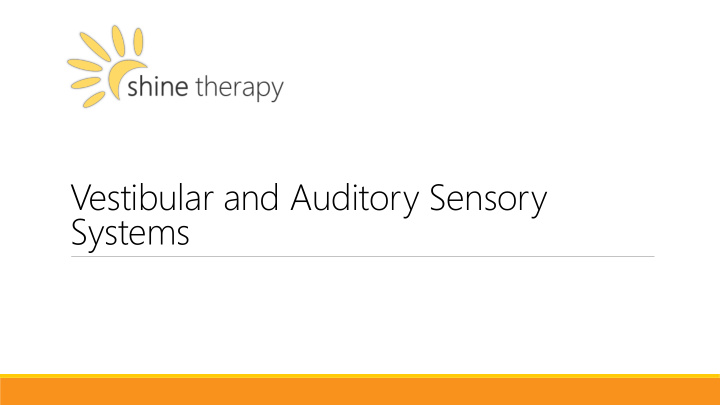



Vestibular and Auditory Sensory Systems
Auditory Modulation difficulties Low Frequency: Hoovers, hand dryers, lawn mowers, hair dryers High Frequency: Children screaming, crying etc Unpredictable Nature of sounds creates anticipation / high arousal levels T argeting behaviours Under responsive: miss verbal information / even loud sounds Strategies: Don’t Jump straight to ear defenders and only use when needed. Music through headphones, large hoods on coats Additional calming strategies (using proprioception and maybe tactile) Radar Key
Vestibular ➢ It is located in our inner ear. ➢ Movement detection system and informs us about movement of our head and body against gravity. ➢ Balance, spatial orientation and maintaining a stable visual image even in motion. ➢ Attention and arousal levels (sleep / wake cycles).
Vestibular Over Under responsive responsive
Over-Responsive Vestibular System ➢ Avoids movement games ➢ Holds on to things when walking, including adults, walls, hand rails, etc / Resistant to transitions ➢ Difficulties coming downstairs. ➢ Poor hand-eye coordination. ➢ Dislikes head tilting backwards (washing hair in bath/lying down for hygiene needs). ➢ Increased anxiety with hoisting ➢ Car / travel sick. ➢ Avoids playground equipment (would rather sit / walk along the periphery). ➢ Poor balance. ➢ Difficulty walking on uneven surfaces. ➢ Cautious and hesitant with movement. ➢ Avoids lifts/escalators Gravitational Insecurity (excessive fear)
Under-Responsive Vestibular System ➢ Excessive spinning or watching things spin. ➢ Doesn’t get dizzy with spinning. ➢ Excessive movement: Climbing, Jumping and Pacing / bouncing. ➢ Difficulty sitting still/ ROCKING IN CHAIR ➢ Reduced attention. ➢ Lacks insight to safety. ➢ YouTube (fast and repetitive movements). ➢ Has to move body to be able to listen. ➢ Head upside down. ➢ Flapping in front of eyes. ➢ Shaking head ➢ Reduced eye control/looks out of the corner of their eyes to stabilise visual field.
Sensory Activities / Strategies
The Do’s and DON’T’s Spinn nning ing is one of the e most st inten tense e sensor nsory exper perien ences ces It is possible to register rotary input correctly in one direction, but not the other. • If the young person constantly spins consider that they aren’t properly registering the input … Redirection • and guidance is required. E.g.. 1 revolution per second … max 10, wait a couple of seconds then facilitate the opposite direction … (ideally prone) 15 minutes of vestibular input can have 6-8 hour ur impact on the brain and self-regulation • Always try an and fo follow w vestibular input with PROPRIOCE RIOCEPTION PTION LIMIT vestibular ibular inpu put t from om late aftern ernoon oon / e early evenin ing
The Do’s and DON’T’s If the young person is over responsive ➢ Can feel sick, dizzy, headaches or even vomit. ➢ DO NOT FORCE THEM TO ENGAGE THEM WITH MOVEMENT BASED ACTIVITIES…Gradual exposure! ➢ Refer to Occupational Therapy (post graduate training in Sensory Integration). ➢ Be aware of what activities make them feel calm, safe, and secure.
Vestibular activities… ➢ Trampoline / Trampet ➢ Space hopper / Core ball / Rodi ➢ Scooters / scooter boards. ➢ Jumping on spot. ➢ Running / shuttle runs (bleep test) ➢ Gorilla gym ➢ Yoga (cosmic kids) / Head between knees and deep breathing. ➢ Animal walks. ➢ Swivel chair (rotary) / Rocking chair ➢ Hanging upside down
Vestibular activities cont … ➢ Swings, slides, see- saw’s ➢ Wheelbarrow walking ➢ Jumping rope / the floor is Lava ➢ Log rolling (make into a burrito with a rug) ➢ Bikes / roller skates / riding push toys ➢ Obstacle courses that require jumping, rolling and crawling ➢ Dancing ➢ Garden swing seats
Example Sensory Diet Wakes up goes straight on trampet (5 mins max) Then goes on Bosu and completes run and crashes This is then followed with peanut squash Free time YP then goes for breakfast and has a weighted lappad and theraband around chair legs YP starts to engage with pacing up and down hallway: this is quickly transitioned to chases / shuttle runs outside. This is then followed with heavy jobs
Recommend
More recommend